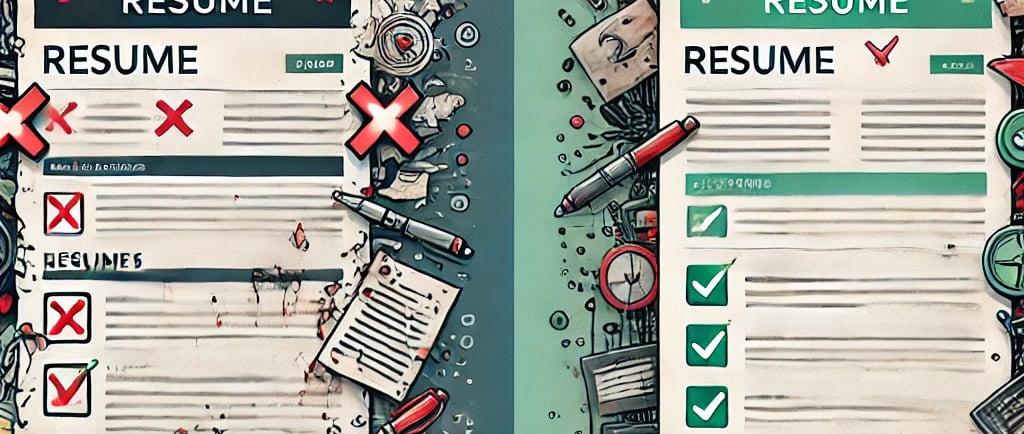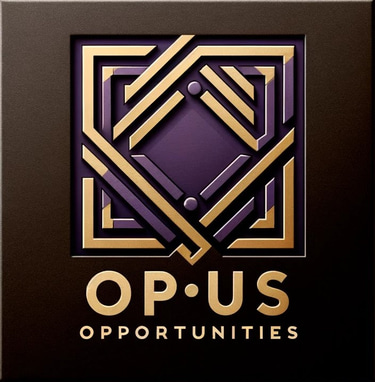Why Your Resume Isn’t Getting Chosen: Common Pitfalls and How to Fix Them
Many job seekers unknowingly make resume mistakes that lead to missed opportunities. Common pitfalls include a lack of customization, overcrowded layouts, absence of quantifiable achievements, and typos. Poor formatting, not being ATS-friendly, and overemphasizing job duties over skills also hurt your chances. To fix these, tailor your resume to each job, focus on measurable accomplishments, maintain a clean and professional format, and ensure it's error-free. By addressing these issues, you can significantly improve your chances of landing an interview.
Jason Elias
8/29/20245 min read


Your resume is often the first point of contact between you and a potential employer, and making a great impression is crucial. Unfortunately, many job seekers unknowingly make mistakes that cause their resumes to be overlooked. Here’s a look at the most common resume pitfalls, based on feedback from HR professionals, and how you can avoid them to boost your chances of landing that interview.
1. Lack of Customization
Why It’s a Problem:
Sending out the same generic resume to multiple employers is a major mistake. Hiring managers can quickly spot a one-size-fits-all resume, signaling that you haven’t taken the time to tailor your application to the specific role.
HR Feedback:
"Resumes that aren’t customized to the job description often get passed over. We’re looking for candidates who show a clear understanding of the role and how their skills align with our needs."
How to Fix It:
Carefully read the job description and customize your resume for each application. Highlight the skills, experiences, and accomplishments that are most relevant to the position.
2. Overcrowded or Cluttered Layout
Why It’s a Problem:
A resume that’s packed with too much information can overwhelm and confuse hiring managers. They typically spend only a few seconds scanning each resume, so clarity and conciseness are key.
HR Feedback:
"When a resume is too cluttered or filled with irrelevant information, it’s hard to quickly identify the candidate’s qualifications. Less is often more—focus on what truly matters."
How to Fix It:
Keep your resume clean and concise. Use bullet points to break up text, stick to a simple format, and remove any irrelevant details. Aim to keep your resume to one or two pages, focusing on your most recent and relevant experience.
3. Lack of Quantifiable Achievements
Why It’s a Problem:
Listing job duties without showing the impact you’ve made can make your resume feel generic and unimpressive. HR professionals want to see how you’ve contributed to your previous roles, and quantifiable achievements are the best way to demonstrate this.
HR Feedback:
"We see a lot of resumes that list responsibilities without any context or results. We’re more interested in the impact you’ve had—numbers and metrics help tell that story."
How to Fix It:
Include specific, measurable achievements in your resume. For example, instead of saying "Managed a sales team," say "Managed a sales team of 10, increasing sales by 20% in the first quarter."
4. Typos and Grammatical Errors
Why It’s a Problem:
Typos and grammatical errors can make a bad first impression, suggesting a lack of attention to detail. These mistakes can lead to your resume being discarded, even if you have the right qualifications.
HR Feedback:
"A single typo can be enough to move a resume to the ‘no’ pile. We expect candidates to present polished, error-free documents—especially if the role requires strong communication skills."
How to Fix It:
Proofread your resume multiple times, and consider asking someone else to review it as well. Tools like Grammarly can also help catch errors you might miss.
5. Poor Formatting
Why It’s a Problem:
An overly complex or poorly formatted resume can be difficult to read and may not display correctly on all devices or in Applicant Tracking Systems (ATS). A resume that’s hard to read won’t keep the attention of hiring managers.
HR Feedback:
"Resumes with inconsistent formatting, unusual fonts, or too many graphics can be distracting and hard to navigate. We prefer a clean, professional layout that’s easy to scan."
How to Fix It:
Stick to a simple, professional format. Use a standard font like Arial or Times New Roman, and keep the formatting consistent throughout. Avoid excessive use of colors, images, or graphics.
6. Not ATS-Friendly
Why It’s a Problem:
Many companies use Applicant Tracking Systems (ATS) to filter resumes before they reach a human. If your resume isn’t ATS-friendly, it might not even be seen by HR.
HR Feedback:
"Resumes that don’t make it through the ATS are never seen by a recruiter. It’s important to use keywords from the job description and avoid formats that ATS can’t read, like graphics-heavy designs or PDFs with complex layouts."
How to Fix It:
Use a simple, text-based format for your resume and include relevant keywords from the job description. Avoid using images, tables, or unusual fonts that might confuse the ATS. Save your resume as a .docx or plain text file, as these formats are typically ATS-friendly.
7. Overemphasis on Job Duties Instead of Skills
Why It’s a Problem:
Listing job duties without highlighting the skills you used or developed can make your resume feel like a job description rather than a showcase of your abilities.
HR Feedback:
"We want to see the skills you bring to the table, not just a list of what you were assigned to do. It’s important to show how your skills contributed to your past roles and how they can be applied to the role you’re applying for."
How to Fix It:
Focus on the skills you’ve developed in each role and how you’ve applied them to achieve results. Include a skills section that highlights both hard and soft skills relevant to the job you’re targeting.
8. Objective Statements Instead of a Strong Summary
Why It’s a Problem:
Objective statements are often vague and outdated. They typically don’t add much value to your resume and can take up valuable space that could be used for a more impactful summary.
HR Feedback:
"We prefer to see a strong summary that quickly tells us who you are and what you bring to the role. Objective statements are often generic and don’t provide enough insight into the candidate’s qualifications."
How to Fix It:
Replace the objective statement with a concise professional summary. Focus on your key skills, experiences, and what makes you a strong fit for the role. This is your chance to make a great first impression, so make it count.
9. Ignoring Gaps in Employment
Why It’s a Problem:
Gaps in employment without explanation can raise red flags for employers. They may wonder what you were doing during that time and whether you’re trying to hide something.
HR Feedback:
"Unexplained gaps in employment are concerning. We appreciate transparency and prefer candidates who address these gaps, even if briefly, to provide context."
How to Fix It:
If you have employment gaps, briefly explain them in your resume or cover letter. Focus on any productive activities during that time, such as freelancing, volunteering, or further education.
10. Lack of a Clear Focus
Why It’s a Problem:
A resume that tries to be all things to all employers can end up being too broad and unfocused. Employers want to see how you fit specifically into the role they’re hiring for.
HR Feedback:
"Resumes that lack a clear focus or seem too broad don’t stand out. We’re looking for candidates who have a clear idea of what they want and how they fit into our organization."
How to Fix It:
Ensure your resume is tailored to the specific role you’re applying for. Highlight the most relevant skills and experiences that align with the job description, and remove anything that doesn’t add value.
Your resume is your ticket to landing an interview, so it’s crucial to make it as strong as possible. By avoiding these common pitfalls and following feedback from HR professionals, you can create a resume that stands out for all the right reasons. Customize your resume, focus on achievements, and ensure it’s error-free, well-formatted, and ATS-friendly. With these tips, you’ll be better positioned to catch the eye of hiring managers and move one step closer to landing your next job.
